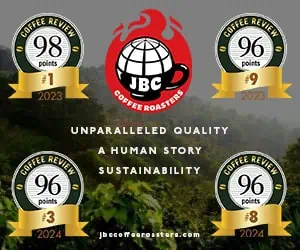Specialty coffee started with a single-store roaster. Or maybe three or four. Alfred Peet’s famous Vine Street store in Berkeley had a little Royal roaster in back of the counter when I first visited it in 1970, the pipe rising precariously (and crookedly, if I remember rightly) toward the high ceiling. Across the Bay in San Francisco Freed Teller & Freed had been roasting in the back room of a store on Polk Street since 1907, keeping the 19th century tradition of in-store roasting alive. Other small craft roasting companies survived the convenience food blitz as well. I particularly remember M.E. Swing in Washington DC, and Don Schoenholt’s Gillies Coffee, founded in 1840 in Manhattan and now in Brooklyn.
But Alfred Peet’s store inspired the most new entrepreneurs, including George Howell and his influential Coffee Connection store in Harvard Square. Eventually, however, single stores turned to multiple stores, multiple stores to vast chains, and the little twelve-kilo roasters in the back room grew to batteries of two baggers in the industrial parts of town. Alfred Peet sold his namesake business long ago, George Howell is consulting and lecturing, and Freed Teller & Freed, sadly, is closing.
However, a new generation of in-store roasters has revived some of the old sass, individualism and hands-on authenticity of specialty coffee’s early history. For a coffee romantic, there is no better way to buy coffee than to stroll down to the local roasting store and buy from the gal or guy who actually buys the green coffee and does the roasting. The coffee is fresh, and so is the advice and information.
Unfortunately, over the past couple of years I have run into a disconcerting number of newish single-store roasters who don’t seem to know how to roast. Or, if they do know, they answer the telephone or wait on customers too often while they’re roasting. All too frequently I have picked up a coffee from a single store roaster, only to find it dried out and badly overroasted, either inadvertently or deliberately in a sort of misunderstanding of the dark-roast style pioneered by Alfred Peet.
Consequently, I approached this cupping of an assortment of coffees from single-store roasters with some apprehension. I thought I might be forced to find ways to be kind to coffees that I really didn’t care for, coffees that had been thoughtlessly or carelessly roasted.
Wonderfully, however, this group of coffees turned out to be one of the better sets I’ve cupped. Maybe I just hit the wrong stores earlier, or maybe I hit the right ones this time. Only one of these coffees was significantly hurt in the roaster. Even those that were brought to an extremely dark, edge-of-possibility roast survived with at least some character intact.
It helped that three of these coffees came from a wonderful new crop of wet-processed Ethiopias just now entering the country. But the most important thing to take away from this cupping for me (in addition to the cup of free Yirgacheffe I just enjoyed) is that the tradition of one-store roasters is being carried forward with skill as well as passion, and that this sampling of the current fruits of that tradition are coffees that are both knowledgeably selected and skillfully roasted.










